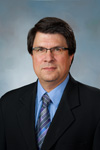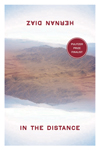Author flips script on typical Western genre
As Hernán Díaz was developing the story for his novel, “In the Distance,” he chose to set his story in the deserts of the American West.
“There’s a strange dissonance to deserts because the vaster the space, the more claustrophobic it feels,” Díaz said. “The story explores themes of loneliness, foreignness and disorientation, and the desert was a natural space for those feelings.”
Díaz will be the first author in the spring University of Houston-Victoria/American Book Review Reading Series. He will read from “In the Distance” at 11 a.m. Jan. 31 in the UHV University West Alcorn Auditorium, 3007 N. Ben Wilson St. The event is free and open to the public.
“Hernán Díaz approaches American history through the eyes of one of the many immigrants who helped make our nation what it is today,” said Jeffrey Di Leo, ABR editor and publisher, and dean of the UHV School of Arts & Sciences. “His unflinching approach to examining personal loneliness and grief in addition to the complicated history of the American West gives us an incredible example of how fiction can provide us with a unique and powerful access to truth.”
“In the Distance” tells the story of a Swedish immigrant searching for his brother and trying to travel east from California during the 1800s when so many people were emigrating west. During his journey, the young man meets a variety of people and, in spite of himself, becomes a legend and an outlaw.
In writing the story, Díaz chose to take a different approach to the usual Western novel. Typically, the genre has a reverent attitude toward what otherwise would be difficult topics, he said.
“The traditional Western gives a cool veneer to lawlessness and violence,” Díaz said. “Very brutal, objectionable aspects of our past are glamorized as part of an American ideal or glossed over. I wanted to use this story to reexamine how our history has been rewritten for a popular genre.”
Although his book explores serious themes and issues, above all Díaz hopes attendees will be moved by his work.
“As an author, that’s my highest ambition,” he said. “I don’t really aspire to teach or convert anyone with my writing. I just hope they will be moved.”
Other writers scheduled for the spring UHV/ABR Reading Series are:
Nalo Hopkinson, Feb. 21 – Hopkinson was born in Kingston, Jamaica, and her birth family lived in Jamaica, Trinidad, Guyana, the U.S. and Canada. In 1997, she won the Warner Aspect First Novel Contest for her novel, “Brown Girl in the Ring.” She has written and published nine books of fiction and a number of short stories, winning several literary awards. Hopkinson now lives in Southern California and is a professor of creative writing at the University of California, Riverside, where she is a member of a faculty research cluster in science fiction.
Paul D. Miller, aka DJ Spooky, March 14 – Miller is the executive editor of ORIGIN Magazine and is a composer, multimedia artist, editor and author. His DJ MIXER iPad app has seen more than 12 million downloads during the last year. He’s produced and composed work for scores of major artists and award-winning films. His work as a media artist has appeared in museums, including The Venice Biennial for Architecture; the Ludwig Museum in Cologne, Germany; The Andy Warhol Museum in Pittsburgh; and many other museums and galleries. His book, “Sound Unbound,” an anthology of writings about electronic music and digital media, is a best-selling title for MIT Press. Miller is a contributing editor to “C-Theory” and the executive editor of Origin Magazine, which focuses on the intersection of art, yoga and new ideas.
Julie Iromuanya, April 11 – Iromuanya has short stories and novel excerpts appearing or forthcoming in the Kenyon Review, Passages North, Cream City Review and the Tampa Review, among other journals. Her writing has been shortlisted for several awards, including the Glimmer Train Family Matters and Very Short Fiction prizes, and the Kenyon Review Short Fiction Contest. She has been awarded scholarships and fellowships for the Sewanee Writers’ Conference, Bread Loaf Writers’ Conference and the Vermont Studio Center. She earned her doctorate from the University of Nebraska-Lincoln and was the inaugural Herbert W. Martin Post-Graduate Fellow at the University of Dayton. A scholar and writer, Iromuanya teaches for the creative writing Master of Fine Arts at the University of Arizona. “Mr. and Mrs. Doctor” is her first novel.
Joseph Tabbi, May 2 – Tabbi is the author of “Cognitive Fictions” and “Postmodern Sublime: Technology and American Writing from Mailer to Cyberpunk.” His biography of William Gaddis, “Nobody Grew But the Business,” was a runner-up for the biography/memoir award from the Chicago Society of Midland Authors. Most recently, he received the N. Katherine Hayles Award for the “Bloomsbury Handbook of Electronic Literature.”
ABR is a nonprofit, internationally distributed literary journal published six times a year. It began in 1977, moved to UHV in 2006 and has a circulation of about 8,000. The journal specializes in reviews of works published by small presses.
Authors are available after each reading to sign copies of their books. Each author also meets with students and attends a community reception.
For more information about the UHV/ABR Reading Series, call the ABR office at 361-570-4101 or go to www.americanbookreview.org.
The University of Houston-Victoria, located in the heart of the Coastal Bend region since 1973 in Victoria, Texas, offers courses leading to more than 80 academic programs in the schools of Arts & Sciences; Business Administration; and Education, Health Professions & Human Development. UHV provides face-to-face classes at its Victoria campus, as well as an instructional site in Katy, Texas, and online classes that students can take from anywhere. UHV supports the American Association of State Colleges and Universities Opportunities for All initiative to increase awareness about state colleges and universities and the important role they have in providing a high-quality and accessible education to an increasingly diverse student population, as well as contributing to regional and state economic development.
Lauren Hightower-Emerson
361-570-4342







